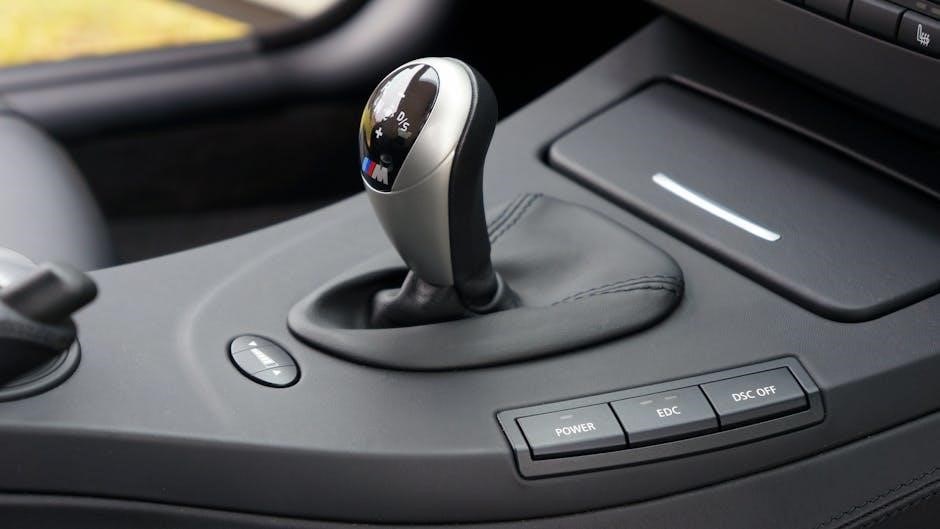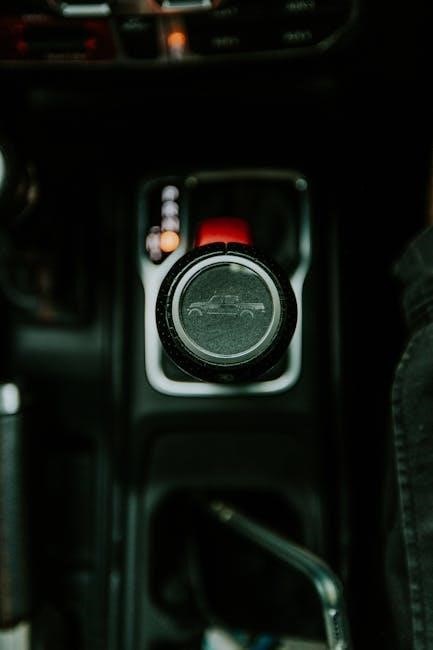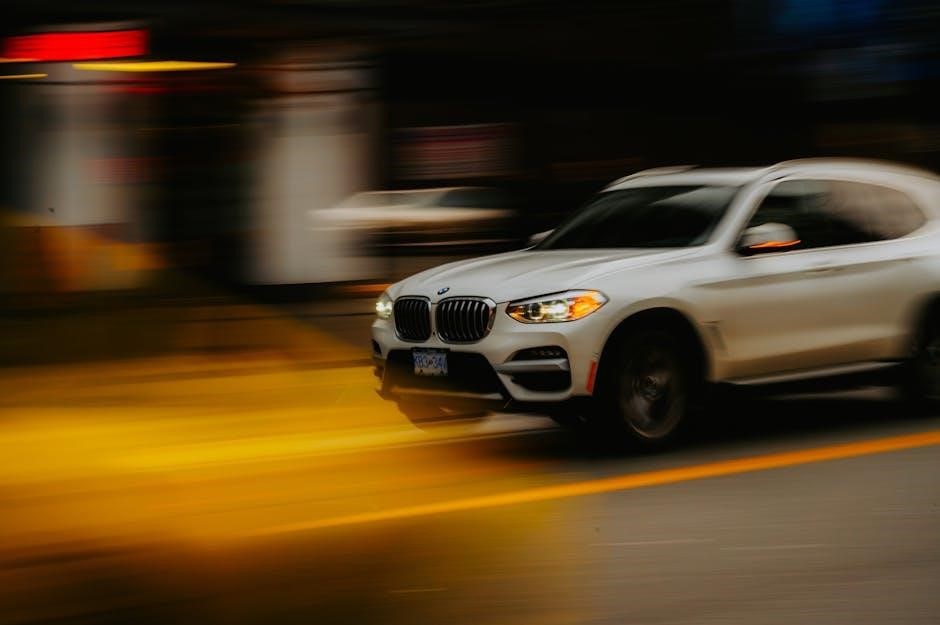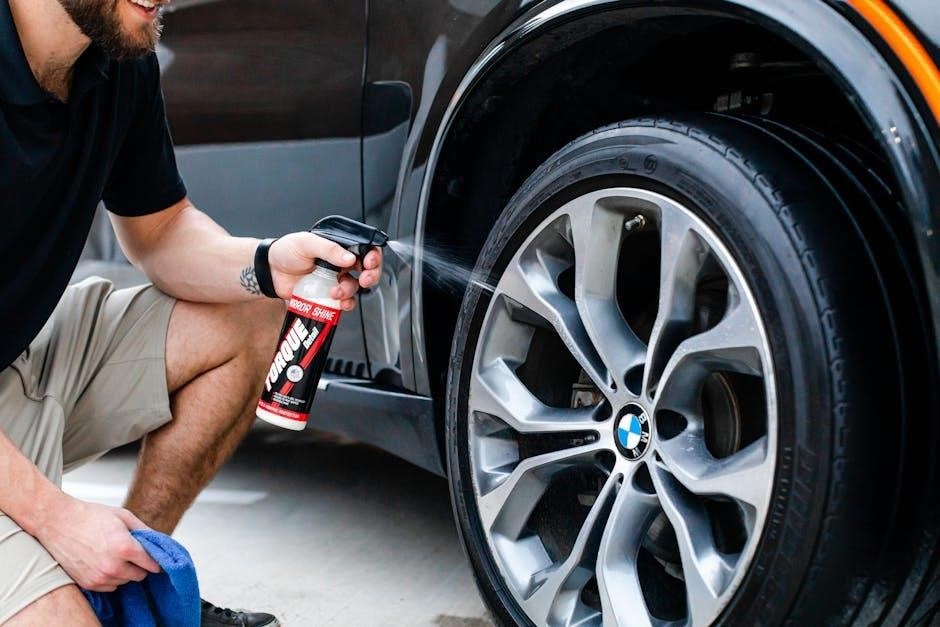The BMW X3 manual gearbox offers a dynamic driving experience, combining precision and control. Available in select model years, it enhances driver engagement with its six-speed design.
Designed for enthusiasts, the manual transmission provides a sporty feel, complementing the X3’s agile handling. It pairs with specific engines, delivering a balance of performance and fuel efficiency.
1.1 Overview of the BMW X3 and Its Transmission Options
The BMW X3, a compact luxury SUV, offers diverse transmission options to suit various driving preferences. While automatic transmissions dominate, select model years, such as the 2004-2010 E83 2.5i and later 3.0i variants, feature a six-speed manual gearbox. These manual models are paired with engines like the 2.5L and 3.0L inline-6, offering rear-wheel drive (sDrive) or all-wheel drive (xDrive) configurations. This setup caters to enthusiasts seeking a more engaging and sporty driving experience.
1.2 Importance of Manual Gearboxes for Driving Enthusiasts
Manual gearboxes are cherished by driving enthusiasts for their tactile connection to the vehicle. They offer precise control over acceleration and gear shifts, enhancing the overall driving experience. In the BMW X3, the manual transmission allows drivers to engage more deeply with the road, fostering a sense of sportiness and personal involvement. This makes it a preferred choice for those who value driving dynamics and a more immersive connection to their vehicle.

History of the BMW X3 Manual Gearbox
The BMW X3 manual gearbox debuted in 2004 with the first generation (E83), offering a six-speed option. Subsequent generations refined this feature, maintaining its appeal for enthusiasts.
2.1 First Generation (E83): 2004-2010
The first-generation BMW X3 (E83) introduced the manual gearbox in 2004, offering a six-speed option for the 2.5i variant. This feature provided a more engaging driving experience for enthusiasts. The manual transmission remained available throughout this generation, alongside automatic options. It catered to drivers seeking a sporty feel and precise control, making it a standout choice in its class during its production run.
2.2 Second Generation (F25): 2010-2017
The second-generation BMW X3 (F25) continued the manual gearbox tradition, offering it in specific models like the 2010 and 2016 variants. This generation saw the manual transmission paired with efficient engines, maintaining its appeal to driving purists. The six-speed manual remained a popular choice, delivering a sporty and connected driving experience, even as automatic options gained prominence in the lineup.
2.3 Third Generation (G01): 2017-Present
The third-generation BMW X3 (G01) introduced in 2017 saw the continuation of the manual gearbox in select models. This generation emphasized performance and efficiency, with the six-speed manual transmission available in certain configurations. Although automatic transmissions dominated, the manual option remained a niche choice for enthusiasts, offering a direct and engaging driving experience that aligned with BMW’s heritage of delivering dynamic handling and precise control.

Technical Specifications of the BMW X3 Manual Gearbox
The BMW X3 manual gearbox features a six-speed transmission, compatible with select engines like the 2.0d. It offers rear-wheel (sDrive) and all-wheel drive (xDrive) options, ensuring versatility and performance.
3.1 Engine Options Compatible with Manual Transmission
The BMW X3 offers manual transmission compatibility with select engines, primarily the 2.0d diesel engine and specific petrol variants. These engines are tuned for efficiency and moderate power, making them ideal for drivers seeking a balance between performance and economy. The pairing ensures smooth gear shifts and optimal torque delivery, enhancing the overall driving experience. This setup is particularly popular among enthusiasts who prefer a more engaging drive.
3;2 Transmission Types: 6-Speed Manual Gearbox
The BMW X3 features a 6-speed manual gearbox, designed for precise control and smooth shifting. Available in select model years, this transmission enhances the driving experience with its sporty feel. The 6-speed manual is paired with rear-wheel drive (sDrive) and all-wheel drive (xDrive) options, offering versatility for various driving conditions. Its mechanical simplicity and driver engagement make it a favorite among enthusiasts seeking a more connected driving experience.
3.3 Drivetrain Options: Rear-Wheel Drive (sDrive) and All-Wheel Drive (xDrive)
The BMW X3 manual gearbox is offered with both rear-wheel drive (sDrive) and all-wheel drive (xDrive) options. The sDrive provides a classic driving experience with optimal weight distribution, while xDrive delivers enhanced traction and stability in various conditions. Both drivetrains are engineered to maximize performance, ensuring a dynamic and responsive ride whether on paved roads or off-road terrains, catering to diverse driver preferences and needs.
3.4 Performance Metrics: Acceleration and Fuel Efficiency
The BMW X3 manual gearbox delivers impressive performance with a 0-60 mph time of around 8.5 seconds in the 2.5i model, offering quick acceleration. Fuel efficiency is also noteworthy, with the sDrive20i achieving up to 21 mpg city and 28 mpg highway. The xDrive20d diesel variant provides even better economy, with a combined 24 mpg, making the manual X3 a balanced choice for both driving enthusiasts and practical commuters.

Driving Experience with the BMW X3 Manual Gearbox
The BMW X3 manual gearbox offers enhanced control and a sporty feel, providing a more engaging driving experience for enthusiasts who value precision and connection to the road.
4.1 Handling and Control with Manual Transmission
The BMW X3 with a manual gearbox delivers precise handling and enhanced control, offering a more immersive driving experience. The six-speed manual transmission allows for smooth, deliberate shifts, enabling better connection to the road. This setup maximizes the X3’s agility, making it highly responsive to driver input. The sporty feel of the manual gearbox complements the vehicle’s dynamic capabilities, providing enthusiasts with a more engaging and rewarding drive.
4.2 Driver Engagement and Sporty Feel
The manual gearbox in the BMW X3 amplifies driver engagement, offering a sporty feel that appeals to enthusiasts. Each shift provides tactile feedback, fostering a deeper connection between the driver and the vehicle. The precise control over gear changes enhances the driving experience, making it more enjoyable and dynamic. This setup is particularly praised for its ability to deliver a more immersive and thrilling ride compared to automatic transmissions.
4.3 Fuel Efficiency and Cost Savings
The BMW X3 manual gearbox offers improved fuel efficiency, particularly in city driving and steady highway conditions. Drivers can optimize fuel consumption by controlling gear shifts, reducing reliance on automatic systems. Additionally, manual transmissions often have lower purchase prices and maintenance costs compared to automatics, making them a cost-effective choice for budget-conscious enthusiasts seeking a blend of performance and economy.

Maintenance and Repair of the BMW X3 Manual Gearbox
Regular maintenance is crucial for the longevity of the BMW X3 manual gearbox. This includes checking transmission fluid levels, inspecting for leaks, and monitoring clutch wear. Addressing issues early can prevent costly repairs, such as replacing worn synchromesh or bearings. Proper care ensures smooth operation and extends the gearbox’s lifespan, maintaining the vehicle’s performance and efficiency over time.
5.1 Maintenance Tips for Longevity
Regular maintenance is essential for extending the life of the BMW X3 manual gearbox. Check transmission fluid levels periodically and inspect for any signs of leakage. Monitor clutch wear and replace worn components promptly to avoid premature damage. Ensure proper alignment of the drivetrain and avoid extreme driving conditions that may strain the gearbox. Follow the recommended service schedule and use high-quality synthetic fluids to maintain smooth operation and prevent costly repairs.
5.2 Common Issues and Repair Solutions
Common issues with the BMW X3 manual gearbox include worn clutch facings and synchro rings, which can cause difficulty shifting gears. Leaks from the transmission housing or input shaft seal may require gasket replacements. Noisy operation could indicate worn bearings or damaged gear teeth. Solutions involve replacing faulty components, such as the clutch kit or bearings, and ensuring proper alignment during reassembly. Regular inspection and timely repairs can prevent major breakdowns and extend gearbox life.
5.3 Cost of Replacement and Repair
Replacing a BMW X3 manual gearbox can range from $1,500 to $4,000, depending on the model year and condition. Repair costs vary, with clutch replacements averaging $1,000 to $1,500. Labor costs add $300 to $600, depending on the workshop. Buying a refurbished or used gearbox can reduce expenses. Regular maintenance and addressing issues early help minimize repair costs. Ensure to purchase parts from reputable dealers or specialists for reliability and warranty coverage.

Availability of Manual Transmission Variants
Manual transmission variants are available in earlier BMW X3 models like the E83 and F25 and can be found through dealerships or third-party sellers, though less common now.
6.1 Current Models with Manual Transmission
As of the latest updates, BMW no longer offers manual transmission in current X3 models, focusing on automatic and Steptronic systems. However, enthusiasts can still find manual variants in used car markets.
Used models from earlier generations, such as the E83 and F25, are available with manual gearboxes. These can be sourced through certified dealers or online platforms like CarGurus and Carvana, catering to specific regional demands.
6.2 Discontinued Models with Manual Transmission
BMW discontinued manual transmission options for the X3 in recent years, focusing on automatic variants. However, earlier models like the E83 (2004-2010) and F25 (2010-2017) generations offered manual gearboxes, particularly in the 2.5i and 3.0i variants.
These discontinued models remain popular among driving enthusiasts, offering a unique blend of performance and control that appeals to purists seeking a more engaging driving experience.
6.3 Regional Availability and Market Demand
Manual transmission BMW X3 models are predominantly available in North America and Europe, with limited offerings elsewhere. Market demand varies, with higher interest in regions like the US, where driving enthusiasts prefer the manual option for its sporty feel.
In contrast, automatic transmissions dominate in other markets, reflecting regional driving preferences and the growing trend toward convenience-oriented vehicles.

Buying Guide for a Used BMW X3 with Manual Gearbox
When purchasing a used BMW X3 with a manual gearbox, prioritize checking mileage, maintenance history, and model year. Focus on E83 and F25 generations for reliability and value.
Explore platforms like CarGurus and Carvana for listings, ensuring the vehicle meets your budget and driving preferences.
7.1 Key Features to Look For
When evaluating a used BMW X3 with a manual gearbox, prioritize model years like the E83 (2004-2010) and F25 (2010-2017) for reliability. Ensure the six-speed manual transmission is in good condition, with smooth gear shifts and no unusual noises. Look for the GS6X37BZ/DZ transmission code for compatibility. Check the vehicle’s maintenance history, focusing on transmission servicing. Verify the Auto Start/Stop function if equipped. Test drive to confirm smooth operation and responsiveness. Opt for models with lower mileage and a clean VIN report for added assurance.
7.2 Model Years to Consider
For a used BMW X3 with a manual gearbox, focus on model years 2004-2010 (E83) and 2010-2017 (F25). These generations offer reliable manual transmissions, with the E83 providing the initial six-speed option. The F25 refined the design, ensuring smoother shifts and better integration with engines like the 2.5i and 3.0i variants. Avoid the G01 (2017-present) as manual options were discontinued. Prioritize low-mileage, well-maintained units from these years for optimal performance and longevity.
7.3 Where to Find Manual Transmission X3 Models
Manual transmission BMW X3 models can be found on platforms like CarGurus, Carvana, and specialized BMW forums. Check used car marketplaces, BMW dealerships, or enthusiast communities for listings. VIN-specific searches and regional classifieds may also yield results. Consider contacting BMW specialists like Parkers or BM Engine Works for verified units. Ensure to inspect maintenance history and documentation before purchasing.

Comparison with Automatic Transmission Models
The manual gearbox offers a sporty, hands-on driving experience, while automatic models prioritize convenience. Manual transmissions often provide better fuel efficiency and lower costs, appealing to enthusiasts.
8.1 Performance Differences
The BMW X3 with a manual gearbox delivers precise acceleration control, enhancing driver engagement. Automatic models, while smoother, may lack the direct connection of manual shifting. Manual transmissions often excel in fuel efficiency and cost-effectiveness, making them a preferred choice for driving enthusiasts seeking a more involved experience behind the wheel.
8.2 Fuel Efficiency Comparison
The BMW X3 with a manual gearbox typically offers slightly better fuel efficiency compared to its automatic counterpart. Manual transmissions often achieve higher MPG ratings due to their direct power delivery. However, the difference is minimal, and actual efficiency depends on driving habits. Both options feature BMW’s efficient engine technology, ensuring optimal performance and economy. Manual models may also benefit from features like Auto Start/Stop, further enhancing fuel-saving capabilities.
8.4 Driver Preference and Use Cases
Manual gearboxes in the BMW X3 cater to driving enthusiasts who value control and a sporty feel. They are ideal for spirited driving on winding roads, offering a more engaging experience. However, in heavy traffic or urban commuting, automatics are often preferred for convenience. Manual transmissions remain a niche choice, appealing to purists who enjoy the tactile connection with their vehicle, making every drive feel more personal and rewarding.

Future of Manual Gearboxes in BMW X3
BMW may phase out manual gearboxes due to declining demand and rising EV popularity. However, enthusiast demand could preserve manuals in niche models, balancing tradition and innovation.
9.1 BMW’s Stance on Manual Transmissions
BMW has historically supported manual transmissions, especially in performance models like the M2, M3, and M4. However, the company indicates that manual gearboxes may only remain as long as current M generations persist. This shift reflects broader industry trends toward automation and electrification, though BMW aims to maintain a connection to its driving heritage for dedicated enthusiasts.
9.2 Impact of Autonomous and Electric Vehicles
The rise of autonomous and electric vehicles is reshaping the automotive landscape, potentially reducing the demand for manual transmissions. As automation and electrification advance, traditional manual gearboxes may become less relevant. BMW, like many manufacturers, is increasingly focused on automatic transmissions, which align better with autonomous systems; However, enthusiasts continue to advocate for manuals, emphasizing the unique driving experience they provide, even as the industry evolves toward more technologically driven solutions.
9.3 Enthusiast Community and Demand
Despite industry trends, the enthusiast community remains vocal in their support for manual transmissions in the BMW X3. Many drivers value the tactile connection and control that a manual gearbox provides, fostering a passionate demand. This dedicated group continues to advocate for the preservation of manual options, ensuring that BMW considers their preferences in future models, even as the market shifts toward automation and electrification.
The BMW X3 manual gearbox remains a beloved choice for driving purists, offering a unique blend of control and engagement. Its legacy endures, even as automotive trends evolve.
10.1 Final Thoughts on the BMW X3 Manual Gearbox
The BMW X3 manual gearbox remains a timeless choice for driving enthusiasts, offering unparalleled control and engagement. Its precise shifting and sporty feel make it a standout feature in the X3 lineup. While BMW continues to evolve its transmission options, the manual gearbox holds a special place for purists. With a dedicated community and limited availability, it ensures a unique driving experience that continues to captivate fans worldwide.
10.2 Recommendations for Potential Buyers
For those considering a BMW X3 with a manual gearbox, prioritize model years known for reliability, such as the 2010 and 2016 models. Ensure proper maintenance checks, including transmission health and fluid levels. Test drive to assess shifting smoothness and overall performance. Consider consulting enthusiast forums for insights and advice. Purchasing from reputable dealers or verified sellers is strongly recommended to avoid hidden issues. This ensures a satisfying ownership experience for driving enthusiasts.

Frequently Asked Questions (FAQs)
Is the BMW X3 manual gearbox reliable? Yes, with proper maintenance. Can it tow? Yes, but check specifications. What about resale value? It remains competitive for enthusiasts.
11.1 Is the BMW X3 Manual Gearbox Reliable?
The BMW X3 manual gearbox is known for its reliability, with a robust design and strict testing processes. Proper maintenance ensures longevity and consistent performance.
Common issues are rare, but regular servicing is key. Owners report high satisfaction, making it a dependable choice for enthusiasts seeking a durable manual transmission experience.
11;2 Can I Tow with a Manual Transmission BMW X3?
Towing with a manual transmission BMW X3 is feasible, provided you adhere to BMW’s specified towing capacities. Engine torque and drivetrain play crucial roles, with all-wheel drive offering better traction. Ensure your vehicle is equipped with the correct towing hardware and follow manufacturer guidelines for safe towing. Regular maintenance and proper driving techniques are essential for a secure towing experience.
11.3 What Are the Resale Values of Manual X3 Models?
Manual transmission BMW X3 models generally retain decent resale value due to their appeal among driving enthusiasts. Factors like model year, mileage, and maintenance history influence resale prices. Earlier generations, such as the E83 and F25, may see consistent demand, while newer models with manual gearboxes remain rare. Platforms like Parkers list used manual X3s, indicating a niche but steady market presence. Proper upkeep and lower mileage can stabilize or even enhance resale value over time.

